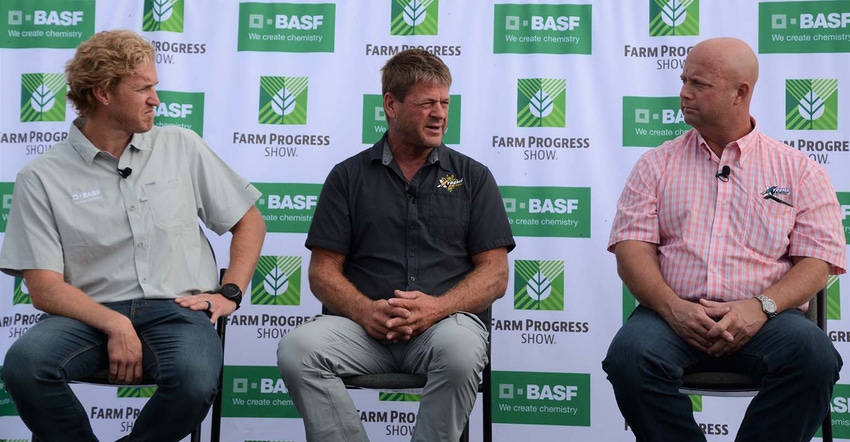
Grain farmers who routinely compete at the highest level in national yield contests admit that big numbers coming across the grain monitor can be a real adrenaline rush. But the high yields themselves are more of a means to an end.
“If you’re in a combine and that machine is just beating her heart out, and the monitor is running up to 350, that will put a smile on your face,” says Oregon, Ill., farmer Dan Luepkes. “But we learn from those acres, and certain things that we started on those acres are now on all acres. We’re chasing profit.”
Dennison, Iowa, farmer Kelly Garrett agrees. “I’m chasing yield on contest acres, but the real priority is to learn on those acres so I can apply it to the farm’s ROI. Big yields are a hobby, but what I’m really chasing is ROI.”
Garrett and Luepke shared their insights at a BASF press conference held on opening day of this year’s Farm Progress Show. Both farmers are members of Xtreme Ag, a group of farmers who share ROI success stories online in videos and podcasts. Luepkes is also an advisor at Corn Warriors, a fast-paced reality TV show tracking farmers through the growing season.
One of the first tips is to join a peer group, such as Xtreme Ag, where you learn how other farmers succeed in different parts of the country.
“In this group we’re very geographically diversified, we’re basically all over the U.S.,” Luepkes says. “I travel to other guys’ farms. Sometimes I’m just amazed at the differences, and I’ve taken things back to my operation that I would never have thought about.”
When the discussion turned to carbon credits, Garrett says his already-in-place practices are tailor-made for monetization.
“I believe that carbon is the most important element we have,” Garrett says. “I want to put as much carbon in the soil as I can. It improves the microbial system and soil health, and there is a huge yield gain from that. We monetize those credits. I didn’t change things to get that money. It just all fell into line. I do it for agronomic reasons.”
Precise fertility
The farmers also discussed some of the changes they’ve made this year. Luepkes says the Extreme Ag collaboration has introduced him to new equipment, but his focus has been on improving fertility.
“We are always trying to dial in our fertility, and every year I learn a little bit more,” Luepkes says. "So, we started trying some higher rates of certain fertility things, most of them micronutrients and we are trying to gauge where that’s going to get us.”
Garrett says in a normal year he has about 25 trials going on at a time, but not all get adopted.
“We are trying a fair amount of 15-inch corn versus 30-inch to space plants out and get a healthier stalk. We continue to try to take our soybean populations lower. I have a trial right beside my house that ranges from 150,000 plants per acre down to 34,000 plants per acre. That’s one of most exciting things for me.”
With corn and soybean prices higher than they have been in seven years, both farmers say it’s wise to invest in fungicides. They try to focus on timing and rates. Garrett has tried different rates of Veltyma, moving from the standard 2 gal. per acre rate to 5 gal. per acre to 20 gal. per acre (same level active ingredient). That seemed to be more effective, he says.
To get high yields you need to try a lot of things and see what works in your soils and management system. Luepkes runs several field trials of 5 to 40 acres before anything gets applied across the farm.
“If something fails miserably it’ll be hard to convince me to use it, but if it’s break even, I’ll probably try it again,” Luepkes says. “It’s a fine line.”
Garrett says he had late escapes of resistant water hemp this year, and with the dry weather some chemistries have not worked well. He is considering a heavier pre-program and maybe fall applications to kill winter annuals.
“Weeds, much like diseases, are tougher and tougher to deal with.”
If one message came through during the short press conference, it’s that learning is one of the most valuable ways to trigger high yields – and profitability.
“If everything works out and we have a big yield for the contest, great, but a lot of things don’t always work,” Luepkes says. “So, I’m trying to learn how I can make the most money on every acre."
“I think you should do better first before you do more,” he concludes. “That’s my philosophy.”
Read more about:
YieldsAbout the Author(s)
You May Also Like






